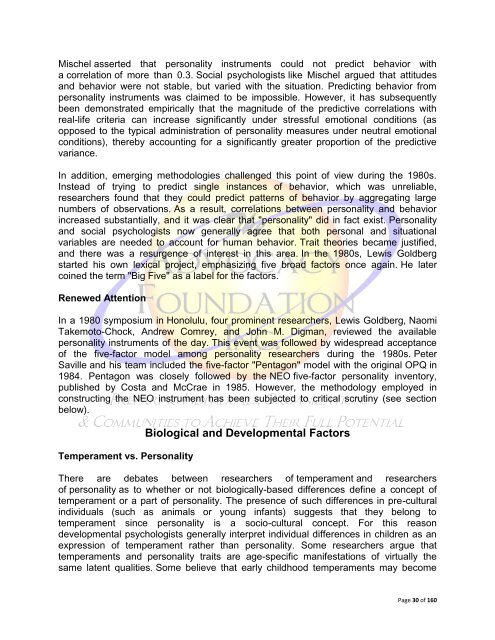The Gift of Introversion
The Gift of Introversion
The Gift of Introversion
Create successful ePaper yourself
Turn your PDF publications into a flip-book with our unique Google optimized e-Paper software.
Mischel asserted that personality instruments could not predict behavior with<br />
a correlation <strong>of</strong> more than 0.3. Social psychologists like Mischel argued that attitudes<br />
and behavior were not stable, but varied with the situation. Predicting behavior from<br />
personality instruments was claimed to be impossible. However, it has subsequently<br />
been demonstrated empirically that the magnitude <strong>of</strong> the predictive correlations with<br />
real-life criteria can increase significantly under stressful emotional conditions (as<br />
opposed to the typical administration <strong>of</strong> personality measures under neutral emotional<br />
conditions), thereby accounting for a significantly greater proportion <strong>of</strong> the predictive<br />
variance.<br />
In addition, emerging methodologies challenged this point <strong>of</strong> view during the 1980s.<br />
Instead <strong>of</strong> trying to predict single instances <strong>of</strong> behavior, which was unreliable,<br />
researchers found that they could predict patterns <strong>of</strong> behavior by aggregating large<br />
numbers <strong>of</strong> observations. As a result, correlations between personality and behavior<br />
increased substantially, and it was clear that "personality" did in fact exist. Personality<br />
and social psychologists now generally agree that both personal and situational<br />
variables are needed to account for human behavior. Trait theories became justified,<br />
and there was a resurgence <strong>of</strong> interest in this area. In the 1980s, Lewis Goldberg<br />
started his own lexical project, emphasizing five broad factors once again. He later<br />
coined the term "Big Five" as a label for the factors.<br />
Renewed Attention<br />
In a 1980 symposium in Honolulu, four prominent researchers, Lewis Goldberg, Naomi<br />
Takemoto-Chock, Andrew Comrey, and John M. Digman, reviewed the available<br />
personality instruments <strong>of</strong> the day. This event was followed by widespread acceptance<br />
<strong>of</strong> the five-factor model among personality researchers during the 1980s. Peter<br />
Saville and his team included the five-factor "Pentagon" model with the original OPQ in<br />
1984. Pentagon was closely followed by the NEO five-factor personality inventory,<br />
published by Costa and McCrae in 1985. However, the methodology employed in<br />
constructing the NEO instrument has been subjected to critical scrutiny (see section<br />
below).<br />
Temperament vs. Personality<br />
Biological and Developmental Factors<br />
<strong>The</strong>re are debates between researchers <strong>of</strong> temperament and researchers<br />
<strong>of</strong> personality as to whether or not biologically-based differences define a concept <strong>of</strong><br />
temperament or a part <strong>of</strong> personality. <strong>The</strong> presence <strong>of</strong> such differences in pre-cultural<br />
individuals (such as animals or young infants) suggests that they belong to<br />
temperament since personality is a socio-cultural concept. For this reason<br />
developmental psychologists generally interpret individual differences in children as an<br />
expression <strong>of</strong> temperament rather than personality. Some researchers argue that<br />
temperaments and personality traits are age-specific manifestations <strong>of</strong> virtually the<br />
same latent qualities. Some believe that early childhood temperaments may become<br />
Page 30 <strong>of</strong> 160

















